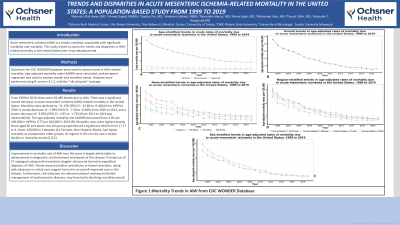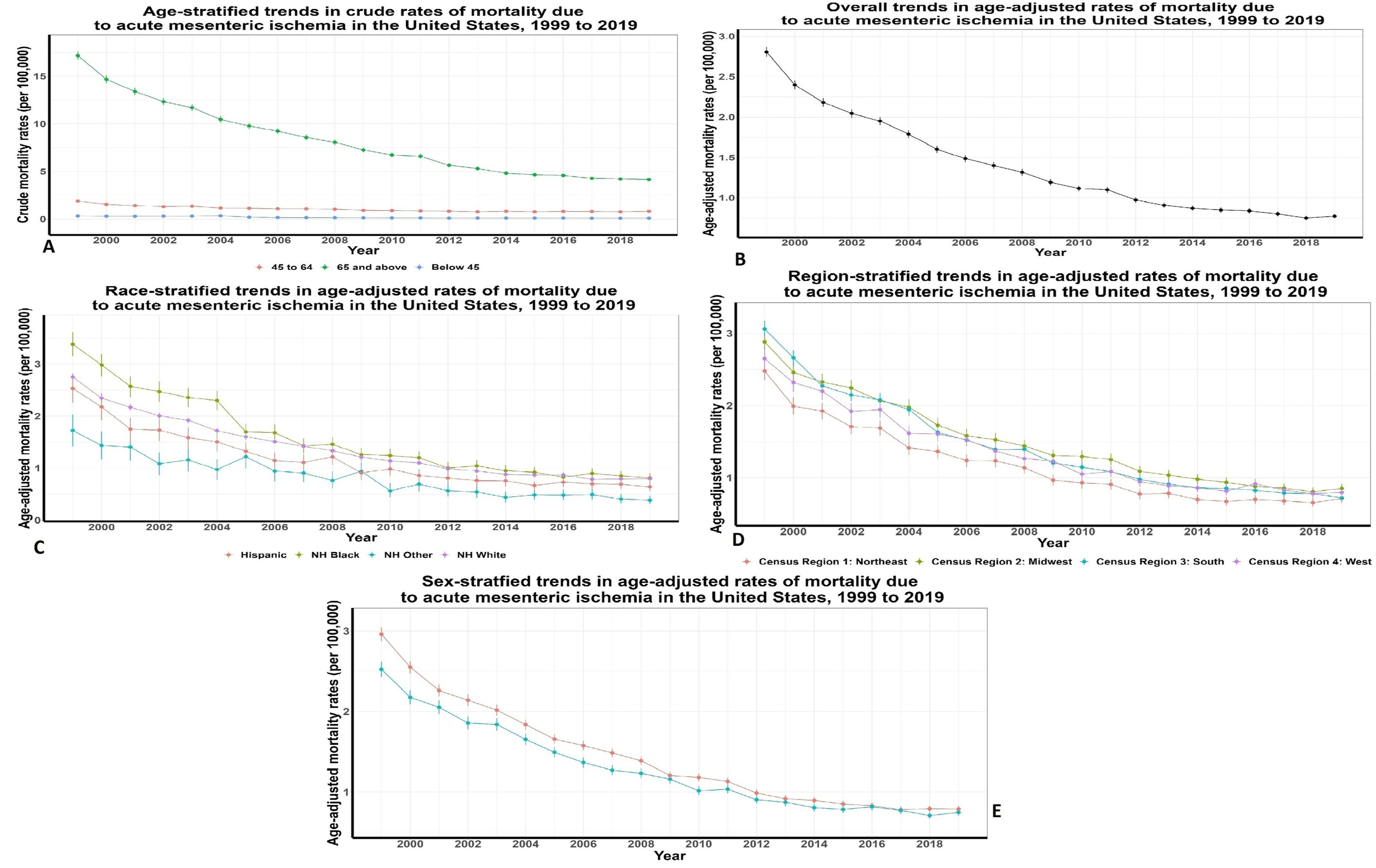Monday Poster Session
Category: Colon
P1593 - Trends and Disparities in Acute Mesenteric Ischemia-Related Mortality in the United States: A Population-Based Study from 1999 to 2019
Monday, October 23, 2023
10:30 AM - 4:15 PM PT
Location: Exhibit Hall

Has Audio

Sophia Dar, MD
Northshore-Long Island Jewish Medical Center
Springfield , IL
Presenting Author(s)
Rehmat Ullah Awan, MD1, Ahmed Sayed, MBBCh2, Sophia Haroon Dar, MD3, Ambreen Nabeel, MBBS1, Nooraldin Merza, MD4, Amna Iqbal, MD4, Mohamad I.. Itani, MD5, Yousaf Zafar, MD6, Ayokunle T.. Abegunde, MD7
1Ochsner Rush Medical Center, Meridian, MS; 2Ain Shams University, Cairo, Al Qahirah, Egypt; 3Northshore-Long Island Jewish Medical Center, New York, NY; 4University of Toledo, Toledo, OH; 5Detroit Medical Center/Wayne State University, Detroit, MI; 6University of Mississippi Medical Center, Jackson, MS; 7Loyola University Medical Center, Maywood, IL
Introduction: Acute mesenteric ischemia (AMI) is a serious condition associated with signficant morbidity and mortality. This study aimed to assess the trends and disparities in AMI-related mortality in the United States over a two-decade period.
Methods: Data from the CDC WONDER database were used to assess trends in AMI-related mortality. Age-adjusted mortality rates (AAMR) were calculated, and jointpoint regression was used to analyze overall and stratified trends. Analyses were performed using R, version 4.1.2, with the "nih.joinpoint" package.
Results: From 1999 to 2019, there were 94,485 deaths due to AMI. There was a significant overall decrease in acute mesenteric ischemia (AMI)-related mortality in the United States. Mortality rates declined by -11.15% [95% CI: -15.60 to -6.46%) from 1999 to 2019. A steady decrease of -7.09% (95% CI: -7.50 to -6.68%) from 2001 to 2013, and a slower decrease of -3.05% (95% CI: -4.35 to -1.73%) from 2013 to 2019 was observed(A,B). The age-adjusted mortality rate (AAMR) decreased from 2.81 per 100,000 in 1999 to 0.77 per 100,000 in 2019 (B). Mortality rates were highest among those aged 65 and above, but this group experienced a significant decline from 17.17 to 4.14 per 100,000 in 2 decades (A). Females, Non-Hispanic Blacks, had higher mortality as compared to other groups, all regions in the country saw a steady decline in mortality trends (C,D,E).
Discussion: Improvement in mortality rate of AMI over the years is largely attributable to advancement in diagnostics and treatment techniques of this disease. Prompt use of CT angiogram along with mesenteric doppler ultrasound has led to expedited diagnosis of AMI. Timely revascularization precedures or bowel resections, along with advances in critical care support has led to an overal improved care in this disease. Furthermore risk reduction via reduced national smoking and better management of cardivascular diseases, may have led to declining mortality overall.

Disclosures:
Rehmat Ullah Awan, MD1, Ahmed Sayed, MBBCh2, Sophia Haroon Dar, MD3, Ambreen Nabeel, MBBS1, Nooraldin Merza, MD4, Amna Iqbal, MD4, Mohamad I.. Itani, MD5, Yousaf Zafar, MD6, Ayokunle T.. Abegunde, MD7. P1593 - Trends and Disparities in Acute Mesenteric Ischemia-Related Mortality in the United States: A Population-Based Study from 1999 to 2019, ACG 2023 Annual Scientific Meeting Abstracts. Vancouver, BC, Canada: American College of Gastroenterology.
1Ochsner Rush Medical Center, Meridian, MS; 2Ain Shams University, Cairo, Al Qahirah, Egypt; 3Northshore-Long Island Jewish Medical Center, New York, NY; 4University of Toledo, Toledo, OH; 5Detroit Medical Center/Wayne State University, Detroit, MI; 6University of Mississippi Medical Center, Jackson, MS; 7Loyola University Medical Center, Maywood, IL
Introduction: Acute mesenteric ischemia (AMI) is a serious condition associated with signficant morbidity and mortality. This study aimed to assess the trends and disparities in AMI-related mortality in the United States over a two-decade period.
Methods: Data from the CDC WONDER database were used to assess trends in AMI-related mortality. Age-adjusted mortality rates (AAMR) were calculated, and jointpoint regression was used to analyze overall and stratified trends. Analyses were performed using R, version 4.1.2, with the "nih.joinpoint" package.
Results: From 1999 to 2019, there were 94,485 deaths due to AMI. There was a significant overall decrease in acute mesenteric ischemia (AMI)-related mortality in the United States. Mortality rates declined by -11.15% [95% CI: -15.60 to -6.46%) from 1999 to 2019. A steady decrease of -7.09% (95% CI: -7.50 to -6.68%) from 2001 to 2013, and a slower decrease of -3.05% (95% CI: -4.35 to -1.73%) from 2013 to 2019 was observed(A,B). The age-adjusted mortality rate (AAMR) decreased from 2.81 per 100,000 in 1999 to 0.77 per 100,000 in 2019 (B). Mortality rates were highest among those aged 65 and above, but this group experienced a significant decline from 17.17 to 4.14 per 100,000 in 2 decades (A). Females, Non-Hispanic Blacks, had higher mortality as compared to other groups, all regions in the country saw a steady decline in mortality trends (C,D,E).
Discussion: Improvement in mortality rate of AMI over the years is largely attributable to advancement in diagnostics and treatment techniques of this disease. Prompt use of CT angiogram along with mesenteric doppler ultrasound has led to expedited diagnosis of AMI. Timely revascularization precedures or bowel resections, along with advances in critical care support has led to an overal improved care in this disease. Furthermore risk reduction via reduced national smoking and better management of cardivascular diseases, may have led to declining mortality overall.

Figure: Mortality Trends in AMI from CDC WONDER Database
Disclosures:
Rehmat Ullah Awan indicated no relevant financial relationships.
Ahmed Sayed indicated no relevant financial relationships.
Sophia Haroon Dar indicated no relevant financial relationships.
Ambreen Nabeel indicated no relevant financial relationships.
Nooraldin Merza indicated no relevant financial relationships.
Amna Iqbal indicated no relevant financial relationships.
Mohamad Itani indicated no relevant financial relationships.
Yousaf Zafar indicated no relevant financial relationships.
Ayokunle Abegunde indicated no relevant financial relationships.
Rehmat Ullah Awan, MD1, Ahmed Sayed, MBBCh2, Sophia Haroon Dar, MD3, Ambreen Nabeel, MBBS1, Nooraldin Merza, MD4, Amna Iqbal, MD4, Mohamad I.. Itani, MD5, Yousaf Zafar, MD6, Ayokunle T.. Abegunde, MD7. P1593 - Trends and Disparities in Acute Mesenteric Ischemia-Related Mortality in the United States: A Population-Based Study from 1999 to 2019, ACG 2023 Annual Scientific Meeting Abstracts. Vancouver, BC, Canada: American College of Gastroenterology.
